The trip second day of the memorial service part2
March 02, 2011
After having lunch rest I made a question to Mr. A living there I would like to know.
"Where are the ashes of the war dead buried?"
In Gilbert Islands, collection of the ashes of the war dead is not in progress. The total death toll reaches more than 5,000 in Tarawa; we visited this time, and Makin having had the same destiny.
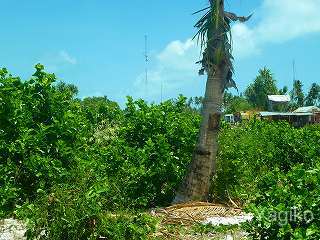 According to Mr. A, US army was said to bury ashes around the runway of the airport Japanese army constructed after the completion of sweeping Japanese army. They dag big hole to bury. In Betio Island, around 4,600 people died and as a matter of fact, very difficult to bury at one place though. Around there nearby, they dag many holes to bury each two to three of dead bodies respectively.
According to Mr. A, US army was said to bury ashes around the runway of the airport Japanese army constructed after the completion of sweeping Japanese army. They dag big hole to bury. In Betio Island, around 4,600 people died and as a matter of fact, very difficult to bury at one place though. Around there nearby, they dag many holes to bury each two to three of dead bodies respectively.
Nowadays, however, around ex-Japanese army runway, local native houses are constructed.
When they dig ground for some reasons and find some ashes, they are checked by Japanese research team and collected as war dead ashes. As of today, only about 400 war dead ashes could return back to homeland. Even if we are sure of around this area, it is very difficult for us to dig ground to find ashes as we like as long as we can not specify its exact spot.
We fully understand this explanation for reason. We also understand it impossible. We, however, feel, at the bottom of my heart, we would like to have as much war dead ash as possible return back to homeland. When I thought of the grandmother who opened white-colored wooden box to find nothing inside, I do wish such research on collection of war dead ashes be done in a hurry as quickly as possible. I do think so. At the place where native house is not constructed and under their consent of approval for its research, I do wish widespread research must be done. Is it impossible? , I wonder.
According to the description in the books I read, many dead bodies were buried in the holes made by bombing or put into the sea. Anyway, there are so many war dead ashes still sleeping behind the green bushes.
We are on the way to Betio War Memorial Park, next destination, relic of battery facing South-West direction with such feeling in our mind.
Here also rusted battery and ruined concrete fence were found. Already destroyed with no keeping the original shape, but seemed to be relic of tochka or turret.
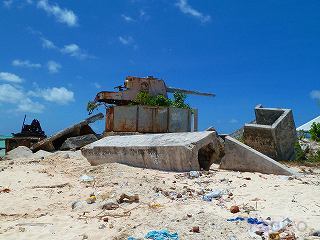
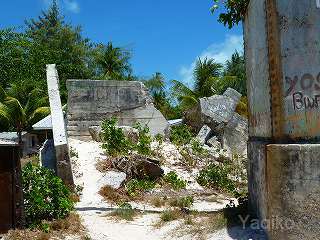
Right near the top ceiling position, there are so many round-shaped holes something like bullet marks if you carefully look at there, and on the box-shaped concrete building, so many similar small holes there. When US army came ashore from the West coast, they forwarded towards the North-West and South-West direction from the landed point. These bullet marks seems to be made at that time.
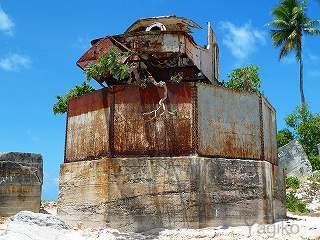
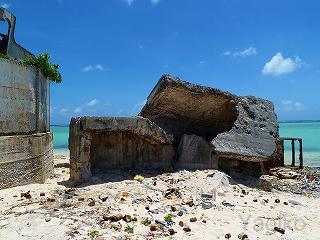
As shown on photos, there found so much rubbish near the war relic as not to pick up any more. Here and there in somewhere around, plenty of rubbish lying on the ground back of the concrete building. We tried to step aside in walking, but our feet was buried in the sand as if trapped in the hole, and failed in pulling up and finally escaped in pulling up with hands out of sand.
What a bad smell!
Something similar to sludge, something greenish, rotted, and muddy clung to my shoes and denim jean. I stopped help washing in the sea water to try to wipe out, but its bad smell remained on. And finished temporary rescue. After I got back to Hotel to try to rewash again with detergent powder, but it’s bad smell still remained on and I had to spend other remaining time in the island with this bad smell slightly remained on with me.
Afterwards we dropped by the big pier (the same place as Japanese army used during the war time, but reconstructed newly nowadays), and went to the relic of the No. 3 Special Base headquarter.
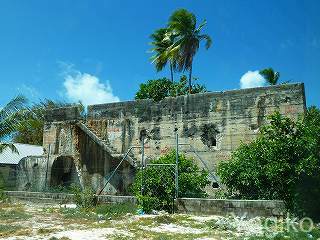
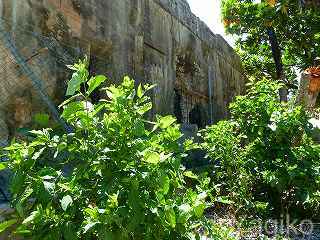
As its relic was bombed by US Air force during the war, there was a big hole on the head-quarter building itself, but remained as they were at that time. These holes, according to Mr. Y, seemed to become bigger in its size than he saw before. The holes made by the fierce battle fight became bigger and bigger year by year as time passed. Unfortunately we could not enter-in due to the fence surrounded with. Just behind its war relic, there was a local people living and just a little short distance, there seems to be small yard, and there seems to be almost no boarder line between its war relic and their private housing are as individual residence in Kiribati has open-minded atmosphere. As we were warned not to enter into native house, we could not walk around there. Two chickens, left at large, were walking on the ground, we saw. There was a very big gap between the many holes of the buildings made by bombing and its peaceful scene. The top right side photo shown was shot by spreading my arm from the back. This shows much more fierce battle held and much heavy damage on the building.
My grandfather belonged to the No.3 Special Base Force, and was just one single soldier, unable to enter into headquartering, but no doubt passed by on her foot. This place may be the one confirmed as closest place to my grandfather.
Although staff of the Ministry of Health, Labor, and Welfare originally planned to hold memorial service at this place, because both my grandfather and Mrs. M's father belonged to the No.3 Special Base Force, nowadays around this area, there are so many private houses and taking their own feeling of living natives into our consideration, we thus decided not to have memorial service here.
As a matter of fact, we understood that there was a big road just in front of the building, though not so nearby like in Japan, but it would be very annoying and troublesome that memorial service was, all of a sudden, to be held in such residential area now. Headquarter had been there so far, but nowadays, here is the place for the native people to spend daily life currently. It is quite difficult for me to explain, but I felt that this place is not a suitable place for me to recall my own grandfather, and gave up. I have already collected some pieces of coral , sand, shellfish with me as memorial at shore, and though that the most suitable place as real memorial service should be nothing but the clear blue sky and sea, by which my grandfather was healed during he spent the days in this island. My father seemed to be a little disappointed at no war relic carried back from this place after my return. I should have carried something back with me for my father, but I still do believe my grandfather is not here in this place.
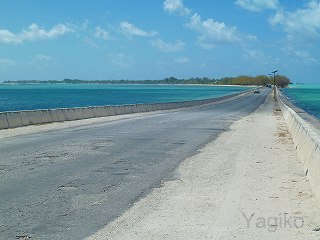 Nowadays Betio Island is directly connected with the Bairiki island, thanks to the reclamation construction road called as "Nippon course way", constructed in 1987 under the economic aid by Japanese government. Nowadays, thanks to this road, native people can easily cross over two islands even at the time of high tide.
Nowadays Betio Island is directly connected with the Bairiki island, thanks to the reclamation construction road called as "Nippon course way", constructed in 1987 under the economic aid by Japanese government. Nowadays, thanks to this road, native people can easily cross over two islands even at the time of high tide.
Betio Island, major fierce battle field, now has become one of the three areas, having the important metropolitan facilities.
